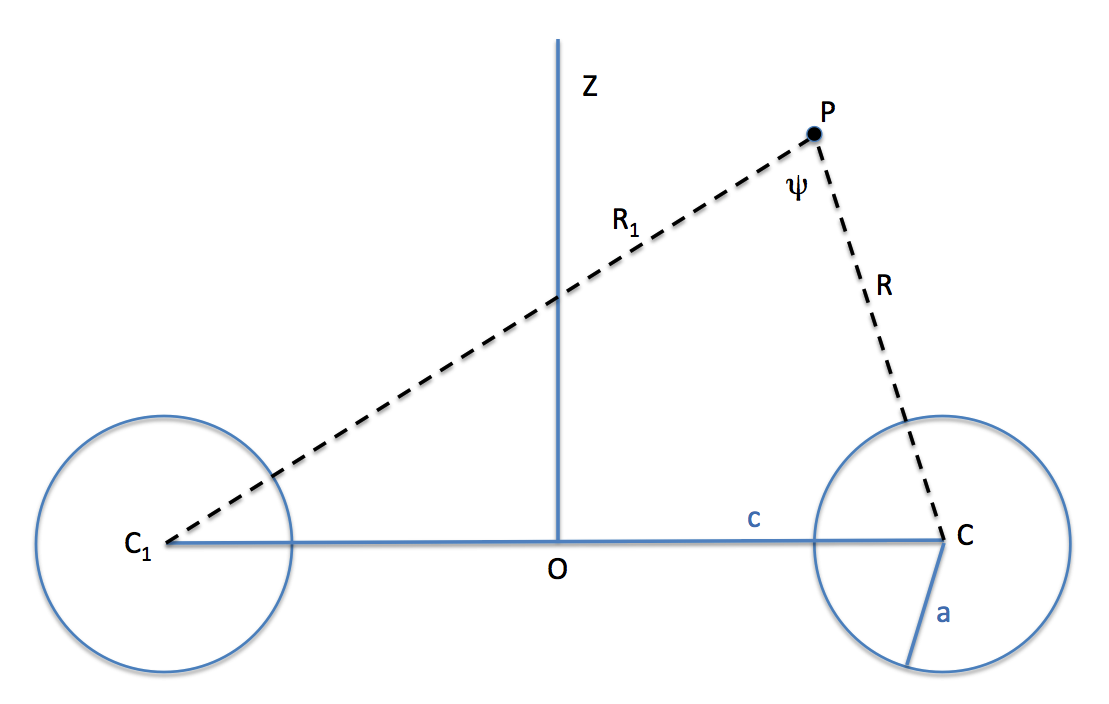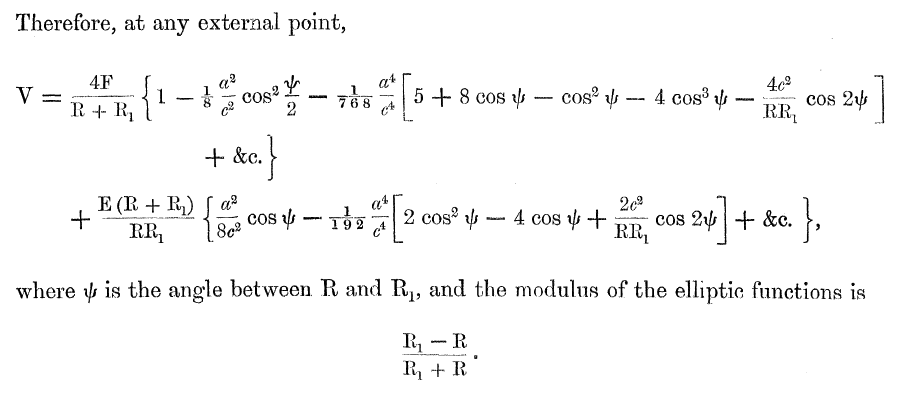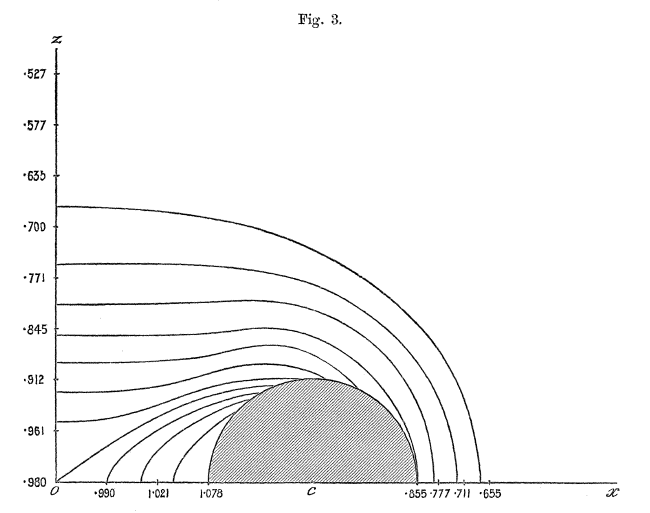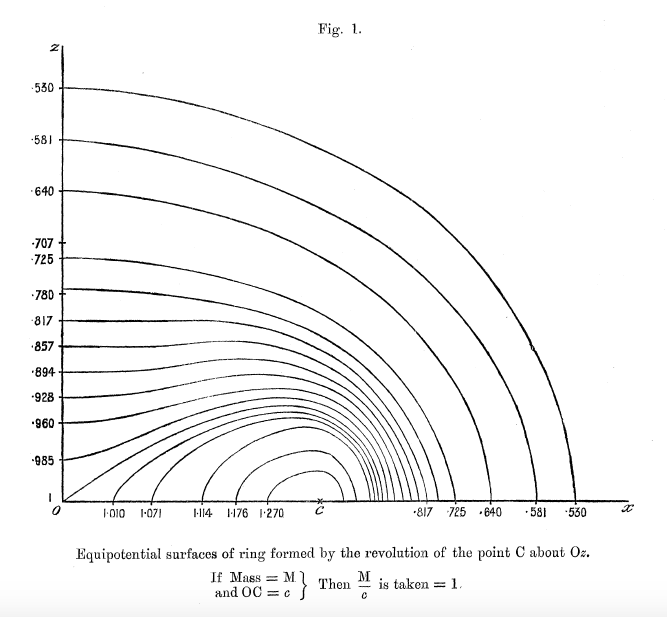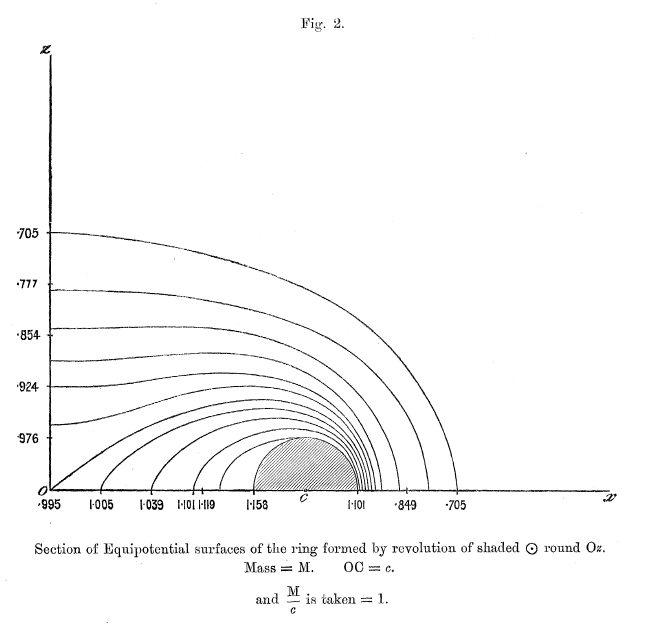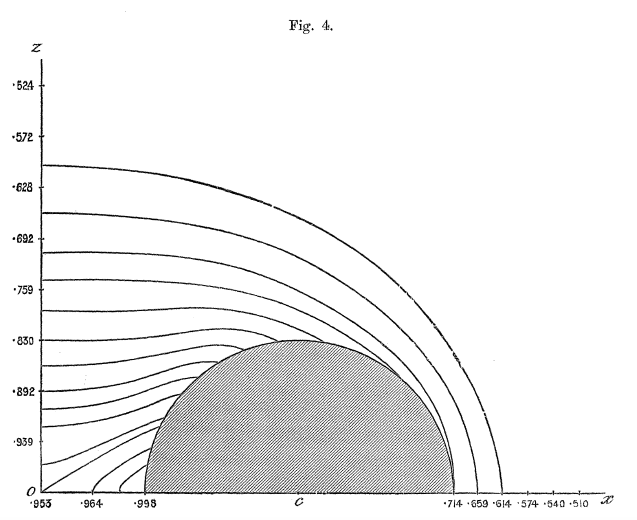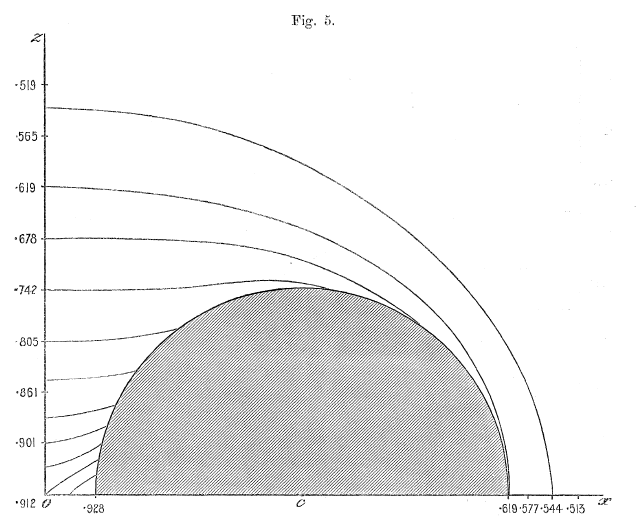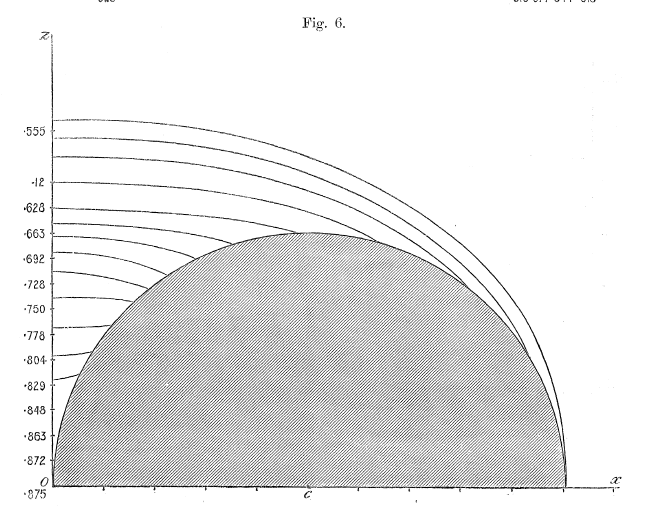Difference between revisions of "User:Tohline/Apps/DysonPotential"
| Line 412: | Line 412: | ||
====Tabulated Data==== | ====Tabulated Data==== | ||
<div | <div id="TabulatedData" style="width: 100%; height: 20em; overflow: auto;"> | ||
<table border="1" cellpadding="5" cellspacing="5" align="center"> | <table border="1" cellpadding="5" cellspacing="5" align="center"> | ||
<tr> | <tr> | ||
Revision as of 20:36, 30 August 2018
Dyson (1893)

|
|---|
| | Tiled Menu | Tables of Content | Banner Video | Tohline Home Page | |
Overview
In his pioneering work, F. W. Dyson (1893a, Philosophical Transactions of the Royal Society of London. A., 184, 43 - 95) and (1893b, Philosophical Transactions of the Royal Society of London. A., 184, 1041 - 1106) used analytic techniques to determine the approximate equilibrium structure of axisymmetric, uniformly rotating, incompressible tori. C.-Y. Wong (1974, ApJ, 190, 675 - 694) extended Dyson's work, using numerical techniques to obtain more accurate — but still approximate — equilibrium structures for incompressible tori having solid body rotation. Since then, Y. Eriguchi & D. Sugimoto (1981, Progress of Theoretical Physics, 65, 1870 - 1875) and I. Hachisu, J. E. Tohline & Y. Eriguchi (1987, ApJ, 323, 592 - 613) have mapped out the full sequence of Dyson-Wong tori, beginning from a bifurcation point on the Maclaurin spheroid sequence.
External Potential
His Derived Expression
On p. 62 of Dyson (1893a), we find the following approximate expression for the potential at point "P", anywhere exterior to an anchor ring:
|
|
Equation image extracted without modification from p. 62 of Dyson (1893a)
The Potential of an Anchor Ring, Phil. Trans. Royal Soc. London. A., Vol. 184 |
In Dyson's expression, the leading factor of <math>~F</math> is the complete elliptic integral of the first kind, namely,
|
<math>~F = F(\mu)</math> |
<math>~\equiv</math> |
<math>~\int_0^{\pi/2} \frac{d\phi}{\sqrt{1 - \mu^2 \sin^2\phi}} \, ,</math> |
where, <math>~\mu \equiv (R_1 - R)/(R_1 + R)</math>. Similarly, <math>~E = E(\mu)</math> is the complete elliptic integral of the second kind.
Comparison With Thin Ring Approximation
In the limit of <math>~a/c \rightarrow 0</math>, Dyson's expression gives,
|
<math>~V_\mathrm{Dyson}</math> |
<math>~=</math> |
<math>~\frac{4K(\mu)}{R+R_1} \, ,</math> |
where we have acknowledged that, in the twenty-first century, the complete elliptic integral of the first kind is more customarily represented by the letter, <math>~K</math>. In a separate discussion, we have shown that the gravitational potential of an infinitesimally thin ring is given precisely by the expression,
|
<math>~\biggl[ \frac{\pi}{GM}\biggr] \Phi_\mathrm{TR}</math> |
<math>~=</math> |
<math>~- \frac{2K(k)}{R_1} \, ,</math> |
where, <math>~k \equiv [1-(R/R_1)^2]^{1 / 2}</math>. Is Dyson's expression identical to this one when <math>~a/c = 0</math> ?
Proof
Taking a queue from our accompanying discussion of toroidal coordinates, if we adopt the variable notation,
<math>~\eta \equiv \ln\biggl(\frac{R_1}{R}\biggr) \, ,</math>
then we can write,
|
<math>~\cosh\eta = \frac{1}{2}\biggl[e^\eta + e^{-\eta}\biggr]</math> |
<math>~=</math> |
<math>~\frac{R^2 + R_1^2}{2RR_1} \, ,</math> |
which implies that,
|
<math>~\biggl[ \frac{2}{\coth\eta +1} \biggr]^{1 / 2} = [1 - e^{-2\eta}]^{1 / 2}</math> |
<math>~=</math> |
<math>~\biggl[ 1 - \biggl(\frac{R}{R_1}\biggr)^2 \biggr]^{1 / 2} \, .</math> |
This is the definition of the parameter, <math>~k</math>, in the expression for <math>~\Phi_\mathrm{TR}</math>. Now, if we employ the Descending Landen Transformation for the complete elliptic integral of the first kind, we can make the substitution,
|
<math>~K(k)</math> |
<math>~=</math> |
<math>~ (1 + k_1)K(k_1) \, , </math> |
where, |
<math>~k_1</math> |
<math>~\equiv</math> |
<math>~ \frac{1-\sqrt{1-k^2}}{1+\sqrt{1-k^2}} \, . </math> |
But notice that, <math>~\sqrt{1-k^2} = e^{-\eta}</math>, in which case,
|
<math>~k_1 </math> |
<math>~=</math> |
<math>~ \frac{1-e^{-\eta}}{1+e^{-\eta}} </math> |
<math>~=</math> |
<math>~ \frac{1-R/R_1}{1+R/R_1} </math> |
<math>~=</math> |
<math>~ \frac{R_1-R}{R_1+R} \, , </math> |
which is the definition of the parameter, <math>~\mu</math>, in the expression for <math>~V_\mathrm{Dyson}</math>. Hence, we can write,
|
<math>~\biggl[ \frac{\pi}{GM}\biggr] \Phi_\mathrm{TR}</math> |
<math>~=</math> |
<math>~- \frac{2}{R_1} \biggl[(1+k_1)K(k_1) \biggr] </math> |
|
|
<math>~=</math> |
<math>~- \frac{2K(\mu)}{R_1} \biggl[1+\frac{R_1-R}{R_1+R} \biggr] </math> |
|
|
<math>~=</math> |
<math>~- \frac{4K(\mu)}{R_1+R} \, .</math> |
Aside from the adopted sign convention, this is indeed precisely the expression given by <math>~V_\mathrm{Dyson}</math> when <math>~a/c = 0</math> .
Evaluation
First, let's test the accuracy of Dyson's (1893a) "series expansion" expression for the elliptic integrals, <math>~K(\mu)</math> and <math>~E(\mu)</math>; in the following table, the high-precision evaluations labeled "Numerical Recipes" have been drawn from the tabulated data that is provided in our accompanying discussion of incomplete elliptic integrals. According to, for example, Wikipedia, the relevant series-expansion expressions are:
|
<math>~K(\mu)</math> |
<math>~=</math> |
<math>~ \frac{\pi}{2} \biggl\{ 1 + \biggl[\frac{1}{2}\biggr]^2\mu^2 + \biggl[ \frac{1\cdot 3}{2\cdot 4}\biggr]^2\mu^4 + \biggl[ \frac{5\cdot 3\cdot 1}{6\cdot 4\cdot 2} \biggr]^2 \mu^6 + \cdots + \biggl[ \frac{(2n-1)!!}{(2n)!!}\biggr]^2 \mu^{2n} +\cdots \biggr\} \, ; </math> |
|
<math>~E(\mu)</math> |
<math>~=</math> |
<math>~ \frac{\pi}{2} \biggl\{ 1 ~-~ \biggl[\frac{1}{2}\biggr]^2\frac{\mu^2}{1} ~-~ \biggl[ \frac{1\cdot 3}{2\cdot 4}\biggr]^2 \frac{\mu^4}{3} ~- ~\biggl[ \frac{5\cdot 3\cdot 1}{6\cdot 4\cdot 2} \biggr]^2 \frac{\mu^6}{5} ~- ~\cdots ~- ~\biggl[ \frac{(2n-1)!!}{(2n)!!}\biggr]^2 \frac{\mu^{2n}}{2n-1} ~-~ \cdots \biggr\} \, . </math> |
These expressions — up through <math>~\mathcal{O}(\mu^4)</math> — can be found in the middle of p. 58 of Dyson (1893a).
| <math>~\mu</math> | Numerical Recipes | Series expansion up through <math>~\mathcal{O}(\mu^4)</math> | ||
| <math>~K(\mu)</math> | <math>~E(\mu)</math> | <math>~K(\mu)</math> | <math>~E(\mu)</math> | |
| 0.34202014 | 1.62002589 | 1.52379921 | 1.6198 | 1.5239 |
| 0.57357644 | 1.73124518 | 1.43229097 | 1.7239 | 1.4336 |
| 0.76604444 | 1.93558110 | 1.30553909 | 1.8773 | 1.3150 |
| 0.90630779 | 2.30878680 | 1.16382796 | 2.042 | 1.199 |
| 0.98480775 | 3.15338525 | 1.04011440 | 2.16 | 1.12 |
In his effort to illustrate the behavior of equipotential contours, Dyson evaluated his expression for the potential up through <math>~\mathcal{O}(\tfrac{a^2}{c^2})</math>; that is, he evaluated the function,
|
<math>~V_2 \equiv V_\mathrm{Dyson}\biggr|_{\mathcal{O}(a^2/c^2)}</math> |
<math>~=</math> |
<math>~ \frac{4K(\mu)}{R+R_1}\biggl[1 - \frac{1}{8}\biggl(\frac{a^2}{c^2}\biggr) \cos^2\biggl( \frac{\psi}{2}\biggr)\biggr] + \frac{(R + R_1)E(\mu)}{RR_1}\biggl[\frac{1}{8}\biggl(\frac{a^2}{c^2}\biggr) \cos\psi \biggr] \, . </math> |
For <math>~c=1</math> and a specification of the ratio, <math>~a/c</math>, take the following steps to map out an equipotential curve that has <math>~V_2 = V_0</math>:
- Choose a value of <math>~R \ge a</math>
- Guess a value of <math>~(c-R) \le R_1 \le (c+R) ~~~\Rightarrow ~~~ \varpi = (R_1^2 - R^2)/(4c)</math> and, <math>~z = \pm \sqrt{ R_1^2 - (c+\varpi)^2}</math>
- Set <math>~ \cos\psi = (R_1^2 + R^2 - 4c^2)/(2RR_1)</math>
- Evaluate the function, <math>~V_2</math>
- If <math>~V_2 \ne V_0</math> to the desired accuracy, loop back up and guess another value of <math>~R_1</math>
- If <math>~V_2 = V_0</math> to the desired accuracy, save the coordinate location, <math>~(\varpi,z)</math>, and loop back up to pick another value of <math>~R</math>
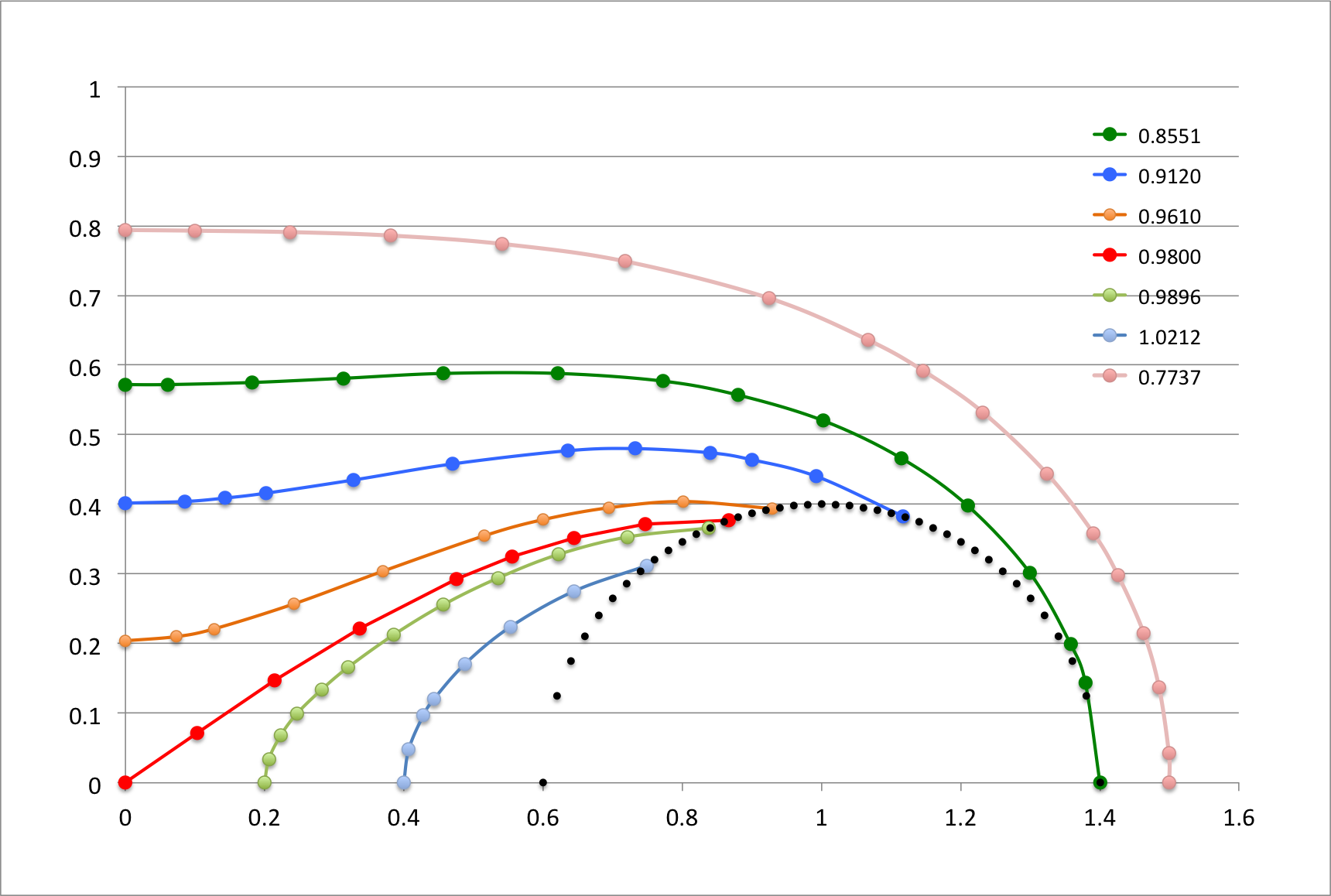 |
| |||||||||
Tabulated Data
|
|
|
|
|
|
| ||||||||||||||||||||||||||||||||||||||||||||||||||||||||||||||||||||||||||||||||||||||||||||||||||||||||||||||||||||||||||||||||||||||||||||||||||||||||||||||||||||||||||||||||||||||||||||||||||||||||||||||||||||||||||||||||||||||||||||||||||||||||||||||||||||||||||||||||||||||||||||||||||||||||||||||||||||||||||||||||||||||||||||||||||||||||||||||||||||||||||||||||||||||||||||||||||||
See Also
- T. Fukushima (2016, AJ, 152, article id. 35, 31 pp.) — Zonal Toroidal Harmonic Expansions of External Gravitational Fields for Ring-like Objects
- W.-T. Kim & S. Moon (2016, ApJ, 829, article id. 45, 22 pp.) — Equilibrium Sequences and Gravitational Instability of Rotating Isothermal Rings
- E. Y. Bannikova, V. G. Vakulik & V. M. Shulga (2011, MNRAS, 411, 557 - 564) — Gravitational Potential of a Homogeneous Circular Torus: a New Approach
- D. Petroff & S. Horatschek (2008, MNRAS, 389,156 - 172) — Uniformly Rotating Homogeneous and Polytropic Rings in Newtonian Gravity
|
The following quotes have been taken from Petroff & Horatschek (2008):
§1: "The problem of the self-gravitating ring captured the interest of such renowned scientists as Kowalewsky (1885), Poincaré (1885a,b,c) and Dyson (1892, 1893). Each of them tackled the problem of an axially symmetric, homogeneous ring in equilibrium by expanding it about the thin ring limit. In particular, Dyson provided a solution to fourth order in the parameter <math>~\sigma = a/b</math>, where <math>~a = r_t</math> provides a measure for the radius of the cross-section of the ring and <math>~b = \varpi_t</math> the distance of the cross-section's centre of mass from the axis of rotation."
§7: "In their work on homogeneous rings, Poincaré and Kowalewsky, whose results disagreed to first order, both had made mistakes as Dyson has shown. His result to fourth order is also erroneous as we point out in Appendix B." |
- P. H. Chavanis (2006, International Journal of Modern Physics B, 20, 3113 - 3198) — Phase Transitions in Self-Gravitating Systems
- M. Ansorg, A. Kleinwächter & R. Meinel (2003, MNRAS, 339, 515) — Uniformly Rotating Axisymmetric Fluid Configurations Bifurcating from Highly Flattened Maclaurin Spheroids
- M. Lombardi & G. Bertin (2001, Astronomy & Astrophysics, 375, 1091 - 1099) — Boyle's Law and Gravitational Instability
- W. Kley (1996, MNRAS, 282, 234) — Maclurin Discs and Bifurcations to Rings
- J. W. Woodward, J. E. Tohline, & I. Hachisu (1994, ApJ, 420, 247 - 267) — The Stability of Thick, Self-Gravitating Disks in Protostellar Systems
- I. Bonnell & P. Bastien (1991, ApJ, 374, 610 - 622) — The Collapse of Cylindrical Isothermal and Polytropic Clouds with Rotation
- J. E. Tohline & I. Hachisu (1990, ApJ, 361, 394 - 407) — The Breakup of Self-Gravitating Rings, Tori, and Thick Accretion Disks
- F. Schmitz (1988, Astronomy & Astrophysics, 200, 127 - 134) — Equilibrium Structures of Differentially Rotating Self-Gravitating Gases
- P. Veugelen (1985, Astrophysics & Space Science, 109, 45 - 55) — Equilibrium Models of Differentially Rotating Polytropic Cylinders
- M. A. Abramowicz, A. Curir, A. Schwarzenberg-Czerny, & R. E. Wilson (1984, MNRAS, 208, 279 - 291) — Self-Gravity and the Global Structure of Accretion Discs
- P. Bastien (1983, Astronomy & Astrophysics, 119, 109 - 116) — Gravitational Collapse and Fragmentation of Isothermal, Non-Rotating, Cylindrical Clouds
- Y. Eriguchi & D. Sugimoto (1981, Progress of Theoretical Physics, 65, 1870 - 1875) — Another Equilibrium Sequence of Self-Gravitating and Rotating Incompressible Fluid
- J. E. Tohline (1980, ApJ, 236, 160 - 171) — Ring Formation in Rotating Protostellar Clouds
- T. Fukushima, Y. Eriguchi, D. Sugimoto, & G. S. Bisnovatyi-Kogan (1980, Progress of Theoretical Physics, 63, 1957 - 1970) — Concave Hamburger Equilibrium of Rotating Bodies
- J. Katz & D. Lynden-Bell (1978, MNRAS, 184, 709 - 712) — The Gravothermal Instability in Two Dimensions
- P. S. Marcus, W. H. Press, & S. A. Teukolsky (1977, ApJ, 214, 584- 597) — Stablest Shapes for an Axisymmetric Body of Gravitating, Incompressible Fluid (includes torus with non-uniform rotation)
- Shortly after their equation (3.2), Marcus, Press & Teukolsky make the following statement: "… we know that an equilibrium incompressible configuration must rotate uniformly on cylinders (the famous "Poincaré-Wavre" theorem, cf. Tassoul 1977, &Sect;4.3) …"
- C. J. Hansen, M. L. Aizenman, & R. L. Ross (1976, ApJ, 207, 736 - 744) — The Equilibrium and Stability of Uniformly Rotating, Isothermal Gas Cylinders
- C.-Y. Wong (1974, ApJ, 190, 675 - 694) — Toroidal Figures of Equilibrium
- C.-Y. Wong (1973, Annals of Physics, 77, 279 - 353) — Toroidal and Spherical Bubble Nuclei
- J. Ostriker (1964, ApJ, 140, 1056) — The Equilibrium of Polytropic and Isothermal Cylinders
- J. Ostriker (1964, ApJ, 140, 1067) — The Equilibrium of Self-Gravitating Rings
- J. Ostriker (1964, ApJ, 140, 1529) — On the Oscillations and the Stability of a Homogeneous Compressible Cylinder
- J. Ostriker (1965, ApJ Supplements, 11, 167) — Cylindrical Emden and Associated Functions
- Gunnar Randers (1942, ApJ, 95, 88) — The Equilibrium and Stability of Ring-Shaped 'barred SPIRALS'.
- William Duncan MacMillan (1958), The Theory of the Potential, New York: Dover Publications
- Oliver Dimon Kellogg (1929), Foundations of Potential Theory, Berlin: Verlag Von Julius Springer
- Lord Rayleigh (1917, Proc. Royal Society of London. Series A, 93, 148-154) — On the Dynamics of Revolving Fluids
- F. W. Dyson (1893, Philosophical Transaction of the Royal Society London. A., 184, 1041 - 1106) — The Potential of an Anchor Ring. Part II.
- In this paper, Dyson derives the gravitational potential inside the ring mass distribution
- F. W. Dyson (1893, Philosophical Transaction of the Royal Society London. A., 184, 43 - 95) — The Potential of an Anchor Ring. Part I.
- In this paper, Dyson derives the gravitational potential exterior to the ring mass distribution
- S. Kowalewsky (1885, Astronomische Nachrichten, 111, 37) — Zusätze und Bemerkungen zu Laplace's Untersuchung über die Gestalt der Saturnsringe
- Poincaré (1885a, C. R. Acad. Sci., 100, 346), (1885b, Bull. Astr., 2, 109), (1885c, Bull. Astr. 2, 405). — references copied from paper by Wong (1974)

|
|---|
|
© 2014 - 2021 by Joel E. Tohline |
